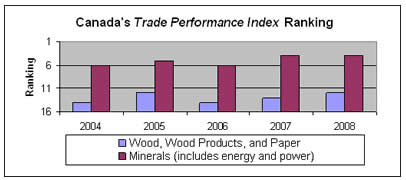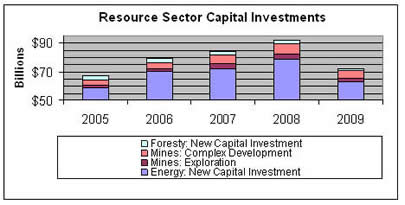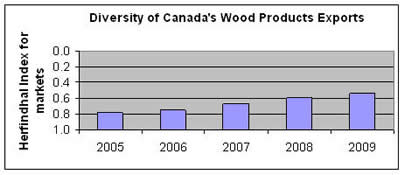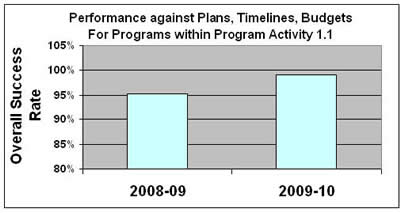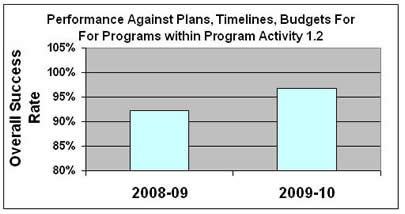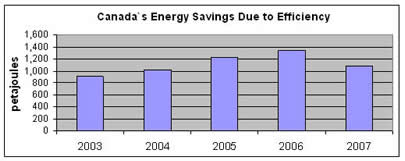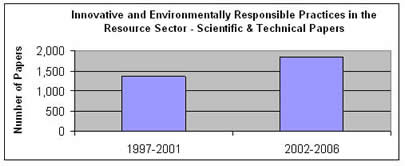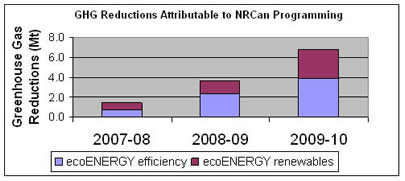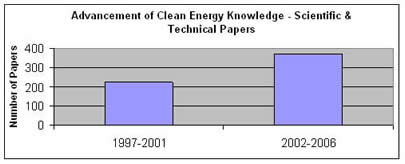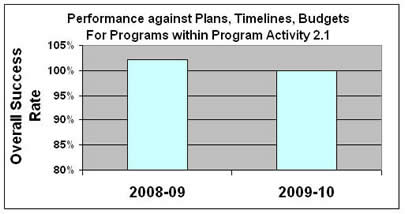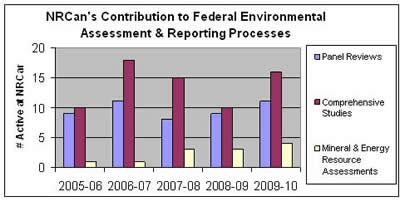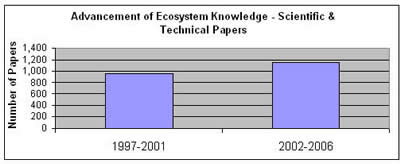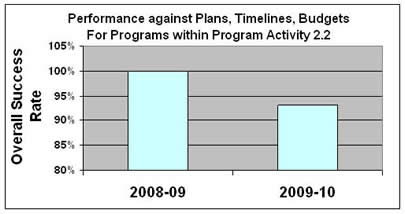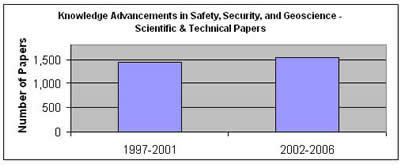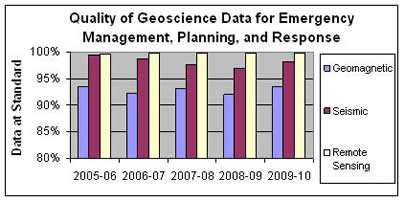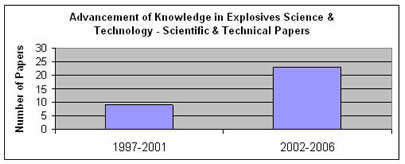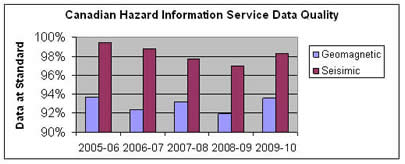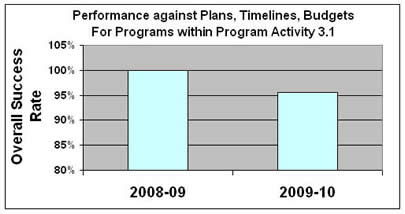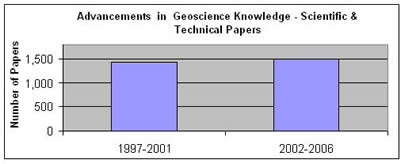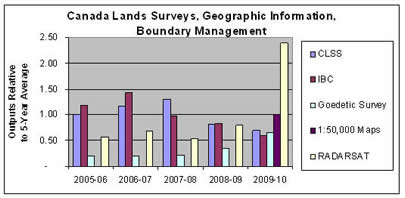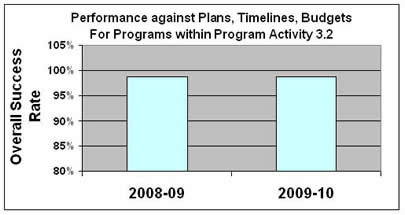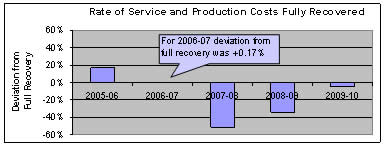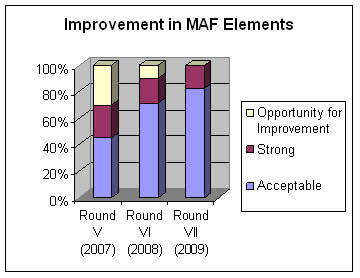Common menu bar links
Breadcrumb Trail
ARCHIVED - Natural Resources Canada - Report
 This page has been archived.
This page has been archived.
Archived Content
Information identified as archived on the Web is for reference, research or recordkeeping purposes. It has not been altered or updated after the date of archiving. Web pages that are archived on the Web are not subject to the Government of Canada Web Standards. As per the Communications Policy of the Government of Canada, you can request alternate formats on the "Contact Us" page.
Section II – Analysis of Program Activities by Strategic Outcome
This section provides performance information on the delivery of programs and EAP initiatives that are critical to the realization of our strategic outcomes and priorities. More information about these programs and initiatives, as well as supporting evidence from internal evaluation and audit reports44, can be found on our website45.
During the reporting period, NRCan monitored and tracked its progress through quarterly reviews, which enabled early detection of problem areas and, wherever possible, implementation of corrective actions to deliver expected results within plans, timelines and budgets. These reviews also identified opportunities for improving performance measures used in the 2009-10 Performance Measurement Framework. The performance measures are currently being addressed by the department. The intention is to improve the quality of the framework, with a view to enhancing decision-making, managing more effectively, and presenting better and more balanced information to Parliament and Canadians. As a result, performance indicators in this document differ from those published in the corresponding 2009-10 Report on Plans and Priorities46.
Strategic Outcome 1 - Economic Competitiveness
This strategic outcome encompasses the long-term objectives of a wide range of NRCan programming directed towards sustaining and strengthening natural resource sectors that are internationally competitive, economically productive, and contribute to the well-being of Canadians.
| 2009-10 Financial Resources ($ millions) - Net |
2009-10 Human Resources (FTEs) |
||||
|---|---|---|---|---|---|
| Planned Spending |
Total Authorities |
Actual Spending |
Planned | Actual | |
| Program | 237.2 | 305.1 | 285.1 | 930 | 913 |
| Statutory | 2,409.3 | 1,764.0 | 1,764.0 | ||
| Expected Results | Performance Indicators | Targets | Status |
|---|---|---|---|
| Natural resource sectors are internationally competitive, economically productive, and contribute to the social well-being of Canadians | Canada’s share of resource-based world trade | Favourable five-year trend | Met All |
Performance Summary
For 2009-10, NRCan met its target for positive trends in Canada's share of resource-based world trade47. In terms of competitiveness, Canada’s rank in wood products trade improved in 2008 (most recent data). Also, Canada’s trade in minerals performance, including energy and power, showed a favourable five-year trend. Canada maintained its position vis-à-vis other countries from 2007-08.
Meeting our commitments
Although emerging from an economic downturn, Canada's trade performance in natural resources was strong. NRCan was working to accelerate economic development, prosperity and sustainability through S&T activities and programs, market development programs, as well as research and analysis as inputs to developing policy and regulations. These sectors are a driving force of Canada’s economy, and in particular, in communities outside large cities.
NRCan, in collaboration with provinces and territories, worked to position Canada’s natural resource sectors to take advantage of opportunities. NRCan's forest-based communities programming was effective at mobilizing partners, as indicated by consistent leveraging of NRCan funding: in 2008-09, NRCan contributed $7.2 million; its two community partnership programs were able to leverage $15.9 million in cash and in-kind contributions from partners to meet common goals.
Supported by NRCan’s programs, the capacity of forest-based and Aboriginal communities to diversify their economies also increased. Evidence indicates that public engagement in local forest policy development and transitional issues is increasing in communities engaged in the Forest Communities Program. Since 2005 there has been an estimated 20 percent increase in the number of partners engaged in community policy initiatives focusing on capacity building.
Benefits to Canadians
The natural resource sectors are a strong engine of economic growth and job creation in Canada. NRCan has been working to offset recent setbacks and support the Canadian natural resource sectors as they develop, adapt and grow. Investments in the natural resource sectors will mean more innovation, jobs for Canadians and a new kind of competitiveness, now and in the future.
Natural resources are also central to the economy of many communities across Canada, and natural resources industries are among the largest private employers of Aboriginal peoples. As the economic downturn and broader restructuring, notably in the forest sector, led to job losses, NRCan worked with communities to mitigate and alleviate the
short-term effects. In the longer term, NRCan is working with partners in the private sector, academia, Aboriginals and other government departments to facilitate skills development as well as business and employment opportunities in Aboriginal communities.
Lessons Learned and Corrective Actions
Throughout the reporting period, NRCan evaluated many of its programs. The knowledge gained from these evaluations was then used to inform program delivery. In particular, several evaluations of forest programs recommended enhancement of performance measurement, regular monitoring and additional resources to expand the dissemination of technology transfer activities. NRCan has addressed these recommendations. It was found that the use of effective local and regional partnerships is key to delivering community-level, capacity-building initiatives, resulting in increased knowledge, skills and capacity to benefit from the evolving natural resource economy within resource-based communities. In addition, a new indicator of partnership effectiveness will be considered to monitor the level of funding leveraged under this strategic outcome.
It has been found that real and durable transformation in the forest sector lies in the synergies between this and other sectors, like energy, that leads to a manufacturing sector that relies on forest fibre inputs, but produces a much broader range of products, including bio-energy and bio-products. Future demonstration investments will be directed toward supporting these technology platforms. Another lesson learned was that future assessments of the performance of the Forest Communities Program will focus on funds leveraged by partnership organizations using seed funding from NRCan.Managing Risks
In the roll-out of a major initiative, the renewal and planned relocation of the CANMET Materials Technology Laboratory, NRCan monitored and managed risks through multi-level oversight mechanisms. Furthermore, NRCan was able to manage the risks associated with the delivery of EAP initiatives so that implementation was both on time and on budget.
NRCan managed its medium to medium-high risk associated with resource-based communities, to ensure a sound alignment of programming and a strong relationship with various stakeholders. To enhance our partnerships, and thereby mitigate program risks, NRCan actively participated in many community-based projects. In addition, our recipient partners followed a well-defined reporting regime to help ensure that desired results were achieved.
Program Activity 1.1 - Economic Opportunities for Natural Resources
This program activity is designed to promote innovation, investment and the enhancement of the competitiveness of Canada's natural resources and related industries through the provision of knowledge and tools, trade development and the removal of barriers, both at home and abroad. This group of programs delivers policies and regulatory and legislative work to manage federal responsibilities
associated with Canada's oil, natural gas and electricity sectors, including critical energy infrastructure protection. It also provides oversight of the statutory programs for the Atlantic Offshore Accords.
| 2009-10 Financial Resources ($ millions) - Net |
2009-10 Human Resources (FTEs) |
||||
|---|---|---|---|---|---|
| Planned Spending |
Total Authorities |
Actual Spending |
Planned | Actual | |
| Program | 226.1 | 290.3 | 274.2 | 868 | 876 |
| Statutory | 2,409.3 | 1,764.0 | 1,764.0 | ||
| Expected Results | Performance Indicators |
Targets | Performance Status |
|---|---|---|---|
| Competitive national and international markets, stable economic opportunity, and investment in natural resources | Capital investments and exploration investments in the resource sector48 | Favourable five-year trend | Met All |
| Diversity of Canada’s wood products exports49 | Favourable five-year trend | Met All | |
| Performance of programs in achieving expected results within plans, timelines, and budgets | Greater than 99% of programs delivered on plan, on time, and within budget (see endnote 14) | Met All |
Performance Summary
As expected during a recession, levels of capital investments declined in 2009 compared to 2008 in Canada’s forests, mines, and energy industries. Despite this, trends over the last five years were positive in the mines and energy sectors, and natural resource-based investment has strengthened Canada’s economy. The declining trend for forestry reflects the profound restructuring that has taken place in that sector. However, the diversity of Canada's wood products exports has increased over the past five years, a positive development as it increases the resilience of Canada's forest sector* to changes in market conditions and consumer demands. Overall, NRCan met its performance target for programs, achieving expected results within plans, timelines, and budgets.
Meeting our commitments
Competitiveness and Innovation
NRCan worked closely with provincial and territorial Ministers responsible for mining to ensure that the mining sector remained competitive and innovative. To this end, Ministers responsible for mining agreed to drive action to improve Canada’s regulatory system to support competiveness and position Canada for economic recovery. For the eighth consecutive year, Canada remained the top destination in the world for exploration spending. In 2009, Canada accounted for 16 percent of total planned world exploration budgets, or $1.2 billion.
In support of the Green Mining Initiative, NRCan established a Multi-Stakeholder External Advisory Committee and federal/provincial/territorial working group to develop new green technology and practices for Canadian businesses to enhance global competitiveness of the Canadian mining industries. As well two research papers were prepared: Status of Green Mining in the Canadian Mining Sector and Study of Green Federal Initiatives and their Relevance to Mining and Exploration Companies.
NRCan engaged with the Atlantic provinces and utilities through the Atlantic Energy Gateway initiative to promote and facilitate the development of clean and renewable energy sources in Atlantic Canada. The initiative is designed to complement all current and future energy plans and resources being undertaken in the region. In addition to helping to reduce greenhouse gas emissions in Atlantic Canada, the initiative is also designed to help the region capture economic benefits from the development and export of clean and renewable energy.
During a period of unprecedented weakness in the US housing market, efforts to diversify geographic markets for Canada’s wood products continued to yield results when they were most needed. The Canada Wood Export Program*50led to significant increases in wood exports to China (up 64 percent to $381 million and a doubling of softwood lumber exports by volume) and South Korea (up 10 percent to $97.7 million) over 2008 levels. NRCan signed a Memorandum of Understanding with the City of Shanghai, China, on the use of wood products for affordable housing construction, which holds the potential to tap into large new markets. The North American Wood First Program*51 continued to increase the use of wood in both Canada and the United States outside of the residential sector, through the provision of education, promotion and technical advice. This included directly influencing the choice of wood in almost 150 non-residential building projects, resulting in an increase in wood sales of more than $100 million. In addition, the Value to Wood Program*52funded 24 research projects at five research organizations across Canada, and supported more than 200 technical projects that will generate new and improved wood products and processes for the secondary wood products manufacturing sector. Finally, the Large-Scale Wood Demonstrations Projects*53 supported six wood-frame demonstration projects in China, South Korea and Italy. For example, wood demonstration projects were erected at Expo 2010 in Shanghai, an event that is expected to draw an estimated 70 million attendees. In South Korea, a four-story duplex was constructed to illustrate how wood-frame construction can be energy-efficient, cost-effective, and in compliance with stringent fire, acoustic and seismic requirements.
Major buyers of wood and paper products worldwide are growing increasingly concerned with the environmental attributes of the products they purchase. Through the Leadership for Environmental Advantage in Forestry (LEAF) Program, NRCan worked with industry and Canadian embassies and consulates to position Canada’s world-class standards for sustainable forest management and environmental stewardship as a market advantage. In 2009-10, LEAF supported activities in the United States, Europe and Asia in areas like green building and procurement policies. For example, advocacy efforts helped influence the development of a green procurement policy by Sears, which included forest certification and represented concrete recognition of Canada’s environmental credentials.
Forest innovation and investment was further supported through the Transformative Technologies Program*54, through which FPInnovations is working to harness emerging and breakthrough technologies. For example, research conducted on nanocrystalline cellulose (derived from forest biomass) helped establish the viability of wood-based materials for the automotive, pharmaceutical and packaging industries. Furthermore, demonstration projects *55 of operational-scale pilot plants are contributing to the commercialization of forest product-based technologies, processes, and products.
New Discoveries of Mineral and Energy Resources
The third phase of NRCan’s Targeted Geoscience Initiative56 (TGI-3), delivered in partnership with industry and universities, provided integrated geoscience knowledge pertaining to areas of high base metal potential, in order to stimulate private-sector
resource exploration. TGI-3 exploration has leveraged significant funding from industry. To date, the TGI-3 expenditure has leveraged more than five times its funding from private investors and has already exceeded this ratio in British Columbia and Manitoba57.
The GeoMapping for Energy and Minerals Program58 (GEM) is focused on public geoscience in the North. In response to the economic downturn, spending was increased by $8 million, to $30 million for 2009-10, and small and medium-sized geophysical firms were contracted for data acquisition work. This accelerated spending enabled GEM to realize a very successful field season in which 9 major airborne surveys were completed. The GEM program is on track to map Canada's North to modern geologic standards; as of March 2010, 41.5 percent of Canada's Arctic region was adequately mapped to modern standards.
The new geological data collected from the 2009 field season was presented at geoscience forums such as the Territorial Geoscience Fora, the Mineral Exploration Roundup and the Prospectors and Developers Association of Canada's annual convention. As a result of the GEM program’s work, industry has significantly increased their staking programs in Labrador, and on the Melville and Cumberland peninsulas in Nunavut.
Another key component of GEM is the establishment of community engagement and local economic opportunities created through field training and employment of community members, as well as good community relations through liaising with local schools and purchasing local goods and services. An Advisory Group of Northerners was established and its advice is being actively followed, in addition to well-established, cost-shared collaborations with provincial, the Polar Continental Shelf Project and industry.
A 2009 evaluation of geoscience programs 59 related to economic opportunities concluded that they capitalized on opportunities to share with partners and stakeholders information, financial and in-kind resources, expertise and data, which has helped to maximize outputs on fixed budgets; contributed to the efficiency of other government departments and industry through the transfer of technology; and achieved significant cost reductions by coordinating data collection and other activities with their partners in other federal departments, provincial governments and the private sector, thereby reducing duplication.
Nuclear Energy Sector Renewal
The government continued to strengthen Canada’s nuclear advantage by providing funding to Atomic Energy of Canada Limited (AECL) for its operations, including the development of the Advanced CANDU Reactor and several programs designed to maintain safe and reliable operations at the Chalk River Laboratories. Following an announcement in
May 2009 that the government was moving forward with the restructuring of AECL, the process towards the divestiture, in whole or in part, of AECL’s commercial CANDU Reactor Division was launched in December 2009, with a call to potential investors to submit proposals.
The transaction is targeted for completion in fiscal year 2010-11. In addition, NRCan also worked with Health Canada to ensure that the best possible information on medical radio-isotopes (specifically, Technetium-99m) was made available to the medical community in Canada in support of health care mitigation measures. An Expert Panel on
Medical Isotope Production was established by the Government in June 2009. The Panel submitted its report60 to the Minister of Natural Resources in November, of the same year. In response to the Panel report, the government of Canada announced in March 2010 – amongst other
measures - NRCan’s Non-reactor-based Isotope Supply Program to invest in research, development and demonstration of novel isotope production technologies.
Contribution in Domestic and International For a
NRCan worked to ensure that Canada’s energy interests would be well-positioned in key international fora in 2010, namely the G8/G20 summits and the World Energy Congress, held in Quebec. In cooperation with the Department of Foreign Affairs and International Trade
(DFAIT) and Environment Canada (EC), NRCan developed and refined Canada’s position related to energy topics in the G8 such as carbon capture and storage, clean energy science and technology, and energy poverty. NRCan also worked closely with DFAIT, Finance Canada and EC in developing Canada’s position on the rationalization and phasing out of inefficient fossil fuel subsidies in preparation for the 2010 G20 Leaders’ Summit. Energy interests were also advanced bilaterally through the Canada-US Energy Consultation Mechanism. A new Memorandum of Understanding
on energy cooperation with India was negotiated, which will help to build commercial opportunities with this important emerging economy.
During 2009-10, NRCan worked closely with DFAIT and CIDA in the implementation of Canada’s Corporate Social Responsibility Strategy. NRCan also participated in key international events, such as China Mining, Indaba (South Africa) and the annual Prospectors and Developers Association of Canada conference, to promote trade and investment for Canada’s minerals, metals and materials. The department led the preparation of expert advice as panel members for the United Nations Commission for Sustainable Development (UNCSD).
Domestically, NRCan organized a series of energy roundtables in fall 2009. These brought together a wide range of senior decision-makers from government, industry, academia, environmental non-governmental organizations, and other key sectors to discuss the next steps for advancing renewable energy production and clean energy research and systems in Canada. As a result of these discussions, NRCan produced a series of reports61 that were shared with stakeholders and members of governments to contribute to ongoing discussions on Canada’s energy future.
Program Activity 1.2 - Natural Resource-based Communities
This program activity is targeted to increase Canada's knowledge of the impacts of the resource sectors on communities that have a substantial reliance on resource-based industries and to improve the capacity and knowledge for increasing the number of opportunities through value-added products and services.
| 2009-10 Financial Resources ($ millions) - Net |
2009-10 Human Resources (FTEs) |
|||
|---|---|---|---|---|
| Planned Spending |
Total Authorities |
Actual Spending |
Planned | Actual |
| 11.1 | 14.8 | 10.9 | 62 | 37 |
| Expected Results | Performance Indicators |
Targets | Performance Status |
|---|---|---|---|
| Increased knowledge, skills and capacity to benefit from the evolving natural resource economy with resource-based communities (both Aboriginal and Non-Aboriginal) | Performance of programs in achieving expected results within plans, timelines, and budgets | Greater than 99% of programs delivered on plan, on time, and within budget (see endnote 14) | Mostly met |
Performance Summary
Overall, NRCan mostly met its performance target for programs, achieving expected results within plans, timelines, and budgets. Although this improved in 2009-10, the department experienced challenges delivering on all elements of this program activity. In the area of mines and minerals, fewer than planned intellectual property kits for assisting communities with competitiveness and environmental performance were completed. In the area of forestry, while key projects and initiatives were implemented, more time is required to realize the full economic impacts of community-based programming. The department’s success in delivering today’s programs is a leading indicator of the capacity of resource-based communities to benefit from the evolving natural resource economy.
Meeting our Commitments
Partnerships and Dialogue
NRCan continued to build international partnerships and signed Memoranda of Understanding with Chile, Brazil, China and India and a Letter of Intent with Mongolia. These are focused on facilitating dialogue on best practices in mining, sharing knowledge and information, exploring opportunities for joint research, and engaging in
cooperative activities that will support the efforts of both countries to promote the sustainable development of their respective mineral-related industries. NRCan worked with DFAIT and CIDA to promote Canada’s Corporate Social Responsibility Strategy
(CSR) participating in multi-stakeholder events/workshops in Canada and internationally (e.g., Australia, Ecuador, Colombia). NRCan hosted the Secretariat and was an active participant in the Intergovernmental Forum on Mining, Minerals, Metals and Sustainable Development to foster cooperation on issues related to improving the contribution
mining, minerals and metals make to sustainable development. NRCan was also an active participant in the African Mining Partnership and engaged in discussions with the UN Commission on Sustainable Development and the World Bank.
Domestically, Canadian mines ministers agreed to leverage Canada’s comparative advantage in mining and identified top priorities going forward62 at the annual Energy and Mines Ministers Conference. Other partnerships and dialogue were fostered through working with the Mining Association of Canada, Vancouver Roundup, and the Prospectors and Developers Association of Canada.
Collaborative Initiatives
In 2009-10, the Forest Communities Program63 and the First Nations Forestry Program64 collectively supported more than 225 community, regional-level, and national partnership projects and initiatives aimed at
increasing the capacity of forest-based and Aboriginal communities to make the transition to more diversified economies. Examples of key projects and initiatives to assist forest-based communities in achieving this outcome include: feasibility studies for communities to take advantage of biomass as a potential source of energy production; projects aimed at Aboriginal youth engagement, skills
development and training; and climate change research and forest management adaptation strategies at the community level.
In addition, NRCan supported the federal Regional Development Agencies responsible for delivering the $1-billion Community Adjustment Fund to create employment opportunities in communities affected by the economic downturn, including those that are resource-dependent.
Strategic Outcome 2 - Environmental Responsibility
This strategic outcome encompasses the long-term objectives of a wide range of NRCan programming directed towards sustaining and strengthening Canada as a world leader in environmental responsibility in the development and use of natural resources.
| 2009-10 Financial Resources ($ millions) - Net |
2009-10 Human Resources (FTEs) |
|||
|---|---|---|---|---|
| Planned Spending |
Total Authorities |
Actual Spending |
Planned | Actual |
| 877.7 | 1,000.9 | 959.0 | 1,287 | 1,211 |
| Expected Results | Performance Indicators |
Targets | Performance Status |
|---|---|---|---|
| Canada is world leader in environmental responsibility in the development and use of natural resources | Canada’s total annual energy savings due to efficiency | Favourable five-year trend | Met All |
| NRCan’s contribution to advancement of innovative and environmentally responsible practices in the resource sector, measured by uptake of knowledge, technologies, and demonstration projects | Favourable long-term trend | Met All |
Performance Summary
NRCan met its targets for positive trends in Canada's total energy savings due to efficiency65, and its contribution to the advancement of innovative and environmentally responsible practices in the resource sectors as measured by the uptake of knowledge, technologies anddemonstration projects. This is evidenced by a 26 percent increase inpublications of scientificand technical papers in 2001-2006 compared to 1997-200166.
Meeting our commitments
Increasingly, access to natural resources and the sustainable ways they are harnessed and used is emerging as a core source of competitive advantage among nations. Economic imperatives are now linked with environmental and social responsibility. NRCan is working to advance Canada’s position in this context through the development of environmentally-friendly technologies, processes and products as well as by encouraging Canadians and industries to improve their environmental performance.
NRCan is also developing knowledge related to aquifers and forest ecosystems to support decision-making on groundwater issues, and the mitigation of risks around natural and human-caused disturbances. For example, NRCan is showing national leadership on S&T related to sustainable forest management, including the development and implementation of a coordinated and risk-based approach to combating forest pests. Furthermore, NRCan is fulfilling its obligations under the Canadian Environmental Assessment Act by conducting environmental assessments on federally regulated projects and for the management of nuclear waste.
Benefits to Canadians
NRCan helped Canadians improve energy conservation and energy efficiency in multiple sectors of the economy (e.g., homes, commercial buildings, vehicles and fleets), contributing to longer term sustainability and reducing the short-term costs of energy consumption. The department also worked to reduce the environmental impacts associated with the production and use of energy, and to increase the production of low-impact renewable energy, thereby advancing the environmental sustainability efforts that will benefit current and future generations.
NRCan’s research in forest ecosystems is providing the scientific knowledge needed to ensure that Canada is a world leader in environmentally responsible development and sustainable use of forest resources. For example, NRCan continued to develop the foundational science for forest management practices in the boreal forest in partnership with universities, the forest industry, and the Government of Alberta. NRCan’s foundational and applied science is essential to enabling policy development and decision-making that supports the sustainability of Canada’s forest and the environmental credentials of the forest industry that relies on it.
NRCan's work and expertise are creating knowledge that enables Canadians to make decisions on environmental stewardship, conservation and environmental protection. This impacts the health and quality of life of Canadians, as well as the sustainability of their natural resources, now and in the future.
Lessons Learned and Corrective Actions
NRCan completed evaluations for Clean Transportation Energy and Cleaner Energy Systems for the Built Environment. Most of the findings indicated that programs were achieving their expected results. However, there were recommendations to clarify definitions and improve planning and reporting processes as well as governance. To address this, an improved governance structure was implemented that directs projects through theme-based portfolios to ensure activities are better managed and coordinated. In addition, a central project management information system was developed to monitor and report activities at the portfolio, program and project levels to facilitate more accurate and detailed financial and performance reporting.
Managing risks
NRCan continued to manage risks pertaining to the long-term relevance and excellence of its S&T activities. Several factors contributed to these risks, including the department’s high proportion of short-term funding and the legacy of an undercapitalized asset base, including specialized facilities and equipment.
During 2009-10, NRCan managed uncertainty in demand for the ecoENERGY Retrofit – Homes Program* by increasing funding to meet unprecedented demand from homeowners. Participation in this program was closely monitored by an Executive Steering Committee which provided additional oversight and advice for decisions related to program management and operational changes.
NRCan took actions to mitigate a medium-high level of risk pertaining to the objectives and structure of NRCan’s clean energy programming. Risk factors include the high proportion of program funding provided on a time-limited basis, and uncertainty surrounding the timing and impacts of potential domestic and international regulatory frameworks for GHG emissions. As per the government's commitment in the 2010 Speech from the Throne67, NRCan plans to review its energy efficiency and emissions reduction programs to ensure they continue to be an effective and efficient use of Canadian tax dollars. The department also engaged with domestic and international partners to ensure that its programs remained aligned with emerging regulatory measures.Program Activity 2.1 - Clean Energy
This program activity encompasses the development and delivery of energy S&T, policies, programs, legislation and regulations to reduce GHG and air pollutant emissions and other environmental impacts associated with energy production.
| 2009-10 Financial Resources ($ millions) - Net |
2009-10 Human Resources (FTEs) |
|||
|---|---|---|---|---|
| Planned Spending |
Total Authorities |
Actual Spending |
Planned | Actual |
| 708.3 | 816.7 | 802.5 | 933 | 921 |
| Expected Results | Performance Indicators |
Targets | Performance Status |
|---|---|---|---|
| Increased energy efficiency, increased production of low-emission energy, and reduced environmental impacts associated with energy production and use | Clean energy production and GHG reductions attributable to NRCan programs |
Favourable long-term trend |
Met All |
| NRCan’s contribution to advancement of clean energy knowledge, and uptake of innovative clean energy solutions | Favourable long-term trend | Met All | |
| Performance of programs in achieving expected results within plans, timelines, and budgets | Greater than 99% of programs delivered on plan, on time, and within budget (see endnote 14) | Met All |
Performance Summary
NRCan met its targets for positive trends in clean energy production and GHG reductions attributable to NRCan programming68, and for its contribution to the advancement of clean energy knowledge and uptake of innovative clean energy solutions69. Through NRCan programming, GHG emissions were reduced by close to 7 megatonnes in 2009-10. The number of clean energy scientific and technical reports almost doubled – an increase from 221 to 372. Innovation, as measured by this indicator, is key to achieving improved environmental responsibility in the energy sector and unlocking tomorrow’s economic opportunities. Overall, NRCan met its performance target for programs, achieving expected results within plans, timelines, and budgets.
Meeting our commitments
The $795 million Clean Energy Fund*70 is supporting long-term technology solutions to reduce and eliminate air pollutants including GHG emissions from the production and use of energy. In 2009-10, $466 million was announced for 3 large-scale carbon capture and storage (CCS) projects71, and a further $146 million for 19 renewable and clean energy systems demonstrations72 across the country. Research, development and demonstration were focused on cleaner fossil fuels, clean integrated electricity, bioenergy systems, low emission industrial systems, clean transportation systems, and the built environment.
The Canada-U.S. Clean Energy Dialogue73 enhanced Canada-U.S. collaboration on clean energy technologies, such as CCS, allowed for continued cooperation on the International Energy Agency Weyburn-Midale Project, and advanced the development of compatible rules, standards and practices. In addition, it facilitated collaboration among Canadian and US electricity regulators, federal departments, agencies and the private sector in respect of reliability standards, cyber-security, training and recruitment, electricity storage, and smart-grid, inter-operability standards. For example, Canada and the U.S. agreed to adapt a building energy benchmarking tool to a Canadian context so that there would be a common commercial building energy rating system in both countries. Research initiatives were also launched that focused on the development of lightweight materials for vehicles, advanced biofuels, electricity demand response potential of buildings, ENERGY STAR, and others. Canada also developed a Memorandum of Agreement with the US on collaborative energy research and development (R&D).
NRCan contributed to the government’s ecoACTION Plan74 through renewable energy, energy science and technology, and energy efficiency initiatives as part of its suite of ecoENERGY75 programs, as detailed below:
The ecoENERGY for Renewable Power76 program signed agreements to fulfill and exceed the 4000 MW of renewable power capacity target. As of March 31, 2010, the program had 100 contribution agreements signed for 4419 MW of capacity, representing a commitment of $1.38 billion over ten years. The program is oversubscribed and is expected to commit the balance of the funding ($50 million) towards projects by the summer of 2010.
The ecoENERGY for Renewable Heat Program77 surpassed its target to support at least 8 residential pilot projects – 14 pilot projects are underway. As well, 363 units have been installed in the industrial, commercial and institutional sectors, and another 301 units have contribution agreements in place for their installation. Two software design tools to support renewable heating design were developed and an additional tool is near completion.
The ecoENERGY Technology Initiative78 supported research that will generate knowledge essential to achieving Canada’s climate change goals. Activities were in the areas of cleaner fossil fuels, cleaner transportation, energy efficiency in residential, commercial and institutional buildings, improved industrial processes, carbon capture and storage, and bioenergy. Significant achievements for the year included: the completion of the first-of-its-kind in Canada, front-end engineering and design study for the EPCOR Genesee Integrated Gasification Combined Cycle plant in Alberta; the Vancouver Fuel Cell Vehicle Program completed five years of demonstration, testing and evaluation of the performance, durability and reliability of five Ford Focus fuel cell vehicles in real world operation; and a project is underway to develop computational tools for virtual testing and design capabilities for assessing advanced structural materials as applied to Generation IV nuclear technology systems.
Several of NRCan’s ecoENERGY initiatives supported continued progress in the energy efficiency of all sectors and increased production and use of alternative transportation fuels in Canada. Notably, during fiscal year 2009-10: ecoENERGY Retrofit*79 provided grants to more than 190,000 homeowners and signed 517 contribution agreements with small and medium-sized organizations. ecoENERGY for Buildings and Houses80 labeled more than 12,000 new homes and 529,000 existing houses, led
technical support workshops, and continued efforts to improve the current National Energy Code for Buildings by 25 percent. ecoENERGY for Industry81 increased energy efficiency in industrial facilities through engagement and workshops, with more than 1,000 industry managers
trained. ecoENERGY for Fleets82 held 88 workshops and developed materials that were used to train 14,000 transportation professionals on energy efficient transportation practices. ecoENERGY for
Personal Vehicles83 provided Canadian consumers with valuable information through the 2010 EnerGuide for Vehicles fuel consumption guide and the Most Fuel Efficient Vehicles list, and more than 350,000 new drivers received in-class training on fuel efficient best driving practices using materials developed by the program.
Further supporting energy efficiency, NRCan developed amendments to the Energy Efficiency Act 84 to regulate standby power, with a view of saving power in more than 300,000 Canadian homes each year.
The ecoENERGY for Biofuels85 program had a total of 21 signed contribution agreements as of March 31, 2010, representing a commitment of $966.2 million and domestic production of 1.6 billion litres of biofuels (1.4 billion litres of ethanol and 0.189 billion litres of biodiesel).
NRCan reports annually on the achievements of its clean energy programs in order to meet obligations under the Kyoto Protocol Implementation Act 86 and the Energy Efficiency Act 87. The department also contributed to international reporting coordinated by Environment Canada in 2009-10, including Canada’s 5th National Communication on Climate Change 88 and Canada’s National Inventory Report 1990-2008 89. Reports are also provided annually on climate change and clean energy programming as an annex to Environment Canada’s Departmental Performance Report.
In addition to supporting the ecoACTION Plan90, NRCan carried out other activities in support of Clean Energy. NRCan contributed to international climate change negotiations, which culminated in 2009-2010 with the development of the Copenhagen Accord. The Accord reflects key Canadian principles, such as a call for a global solution toward long-term emission reductions, including all major emitters; actions by developing countries; and a commitment to financing, particularly for least developed countries. NRCan contributed specific expertise in such areas as technology, financing, adaptation and forestry.
The department’s advanced materials and technologies R&D contributed to the advancement of knowledge and technologies supporting energy efficiency in transportation and clean energy, and as well, contributed to a reduction in GHG emissions and other pollutants. To aid in vehicle weight reduction for greater fuel efficiency, new high-strength steel compositions were developed. New machinery to manufacture lightweight materials was installed at CANMET-MTL and allowed for the first magnesium alloy sheets to be produced in North America. The sustainability of using lightweight materials was validated through a life-cycle assessment. Materials' requirements for high-temperature power generation systems were identified and prototypes of high-temperature alloys, coatings, and ceramic materials were made.
The Pulp and Paper Green Transformation Program91 is investing in Canada’s pulp and paper sector in areas such as energy efficiency and renewable energy production. Agreements totalling more than $182 million were signed. Pulp and paper projects approved in 2009-10 are expected to result in improvements, including more than 500,000 MWh/year of new renewable energy production – enough to power 42,000 homes for a year, and annual energy savings of more than 87,000 gigajoules/year – enough to power 800 homes. This investment will facilitate a reduction of GHG emissions in pulp and paper mills in Canada while helping to position the sector as a leader in forest biomass-based renewable energy.
Program Activity 2.2 - Ecosystem Risk Management
This program activity is designed to promote alternative technologies and practices in green technologies and mining, an understanding of forest dynamics, appropriate approaches for the long-term management of radioactive waste, and the provision of sound scientific advice to support responsible resource management initiatives which advance economic, environmental and social
objectives.
| 2009-10 Financial Resources ($ millions) - Net |
2009-10 Human Resources (FTEs) |
|||
|---|---|---|---|---|
| Planned Spending |
Total Authorities |
Actual Spending |
Planned | Actual |
| 169.4 | 184.2 | 156.5 | 354 | 290 |
| Expected Results | Performance Indicators |
Targets | Performance Status |
|---|---|---|---|
| Canada understands and mitigates risks to natural resource ecosystems and human health | NRCan's contribution to federal environmental assessments, mineral and energy resource assessments for proposed protected areas on federal lands and waters, and related reporting processes | Fulfilling on-demand requirements (no quantitative target because variations in demand are beyond NRCan’s control) | Met All |
| NRCan’s contribution to advancement of ecosystem knowledge, and innovative ecosystem risk management solutions | Favourable long-term trend | Met All | |
| Performance of programs in achieving expected results within plans, timelines, and budgets | Greater than 99% of programs delivered on plan, on time, and within budget (see endnote 14) | Mostly met |
Performance Summary
NRCan continued to meet its target of being a major contributor to federal environmental assessment and reporting processes92 - including both Panel Reviews and Comprehensive Assessments – as required under the Canadian Environmental Assessment Act. In a similar fashion, NRCan contributed its expertise to Mineral and Energy Resource Assessments for the potential establishment of national parks and other protected areas. NRCan met its target for a positive trend in its contribution to the advancement of ecosystem knowledge and innovative ecosystem risk management solutions93: published scientific papers increased by 193 between the two five-year periods of 1997-2001 and 2002-2006 demonstrating NRCan’s continued commitment to advancing ecosystem knowledge and risk management solutions. However, delays were experienced by NRCan in delivering two elements of this program activity. In the area of geoscience for environmental issues, fulfillment of legacy commitments from earlier programming will extend one year beyond the original plan. In the area of radioactive waste management programs, a number of key milestones were achieved, yet the completion of some milestones was delayed. These delays were related to technical and social challenges of the work, as well as certain elements of program delivery, and are similar to those facing other nations dealing with historic and legacy waste liabilities. NRCan formally evaluated these challenges and put in place governance and program management responses that seek to maximize program delivery. Overall, NRCan mostly met its performance target for programs achieving expected results within plans, timelines, and budgets.
Meeting our commitments
Innovative New Technologies
NRCan continued to advance the Green Mining Initiative and at the 2009 Energy and Mines Ministers Conference, provincial and territorial Ministers endorsed the Pan-Canadian Green Mining Initiative (GMI) to improve the mining sector’s environmental performance, ensure international competitiveness, and create green technology opportunities
for Canadian businesses. Also in collaboration with the provinces and territories, NRCan initiated work to develop a compendium of green mining technologies and research being undertaken across Canada. NRCan allocated $8 million to advance 75 green mining projects during 2009-10.
These projects have achieved real results, such as optimized energy consumption, reduced GHG emissions and operating costs, development of first-of-a-kind technologies, applications for domestic and international patents, and land reclamation for biomass crops. Finally, the department enhanced its partnership with the Canadian Mining Innovation Council
which endorsed GMI as a key component of its Mining Research and Innovation Strategy.
Forest Ecosystems Knowledge
NRCan supported Canada’s obligations and advanced its forest-related interests relative to the United Nations Framework Convention on Climate Change (UNFCCC). In 2009-10, the department further developed and applied the Carbon Budget Model, which is now being evaluated and used both within Canada and internationally to monitor and forecast
changes in forest carbon at the national level. The Carbon Budget Model is also providing critical empirical data on Canada’s forests in support of ongoing international climate change negotiations and annual reporting on forest carbon sinks and sources under the UNFCCC. In addition, NRCan launched Canada’s new National Forest Inventory94 and initiated the Canadian Forest Carbon Science Plan, which will help identify key policy questions and research priorities to help guide and align Canadian forest carbon science research with the climate change
agenda of the federal government.
Canada's Groundwater Resources
The department is collaborating with provinces and territories to conduct aquifer assessments that will provide the basis for informed decision-making on groundwater. NRCan is progressing well with its partners to map and assess the remaining 18 of 30 key regional aquifers. Three new aquifer assessments are scheduled to be completed by 2011-12.
Common protocols and standards are being developed in collaboration with partners.
Nuclear Waste Management
Under the department’s oversight and direction, the Nuclear Legacy Liabilities Program continued to reduce risks and liabilities at Atomic Energy of Canada Limited sites through the implementation of projects and activities to decommission out-dated infrastructure, restore lands affected by past operations, and improve the management of legacy waste. Example projects in 2009-10 include the
decommissioning and demolition of five shutdown buildings; completing the solidification of the radioactive liquid waste stored at Whiteshell Laboratories; and completing recovery and clean-up activities for a waste burial at Chalk River Laboratories.
In 2009-10, the Port Hope Area Initiative, overseen by the department, achieved a number of major milestones. Based in part on NRCan’s efforts, the Canadian Nuclear Safety Commission issued a Nuclear Waste Substance Licence for the Port Hope Project and the environmental assessment for the Port Granby Project was completed. Also, two detailed design contracts for these projects were issued by Public Works and Government Services Canada. The department also took ownership of one waste management facility.
Strategic Outcome 3 - Safety, Security and Stewardship
This strategic outcome encompasses the long-term objectives of a wide range of NRCan programming directed towards developing and disseminating natural resource and landmass knowledge, as well as sustaining and enhancing knowledge and management systems that strengthen both the safety and security of Canadians and the stewardship of
Canada’s natural resources and lands.
| 2009-10 Financial Resources ($ millions) - Net |
2009-10 Human Resources (FTEs) |
|||
|---|---|---|---|---|
| Planned Spending |
Total Authorities |
Actual Spending |
Planned | Actual |
| 174.8 | 202.5 | 176.9 | 1,208 | 1,108 |
| Expected Results | Performance Indicators |
Targets | Performance Status |
|---|---|---|---|
| Natural resources and landmass knowledge strengthen the safety and security of Canadians and contribute to the effective governance of Canada | Contribution to the safety and security of Canadians, and the effectiveness of federal land stewardship and regulatory process |
Favourable long-term trend for knowledge advancement Greater than 80% of active or completed MPMO projects within 8 weeks of target timeline Greater than 90% of landmass and natural hazard data meets timeliness and accessibility standards |
Met All for Knowledge Advancement Met All for Federal Regulatory Process for Major Natural Resource Projects Met All for Quality of Geoscience Data |
Performance Summary
NRCan met its target for a positive trend in its contributionto theadvancement of knowledge in safety, security, and geoscience95. In addition,performance met the target for all federal departments and agencies within NRCan’s Major Projects Management Office (MPMO)96. Finally, NRCan continued to exceed its target for landmass and natural hazard system data, meeting timeliness and accessibility standards97. Information from these data systems is used to inform Canadians and technical specialists of important geophysical parameters in near-real-time, including support for hazard and land use management regimes, and climate change monitoring.
Meeting our commitments
By providing authoritative and accessible geographic information, NRCan contributed to the effective governance of Canada, including sound decision-making on land management, sovereign rights and various economic, environmental, safety and security initiatives. To this end, there was significant uptake of NRCan geoscience by federal, provincial and territorial leaders, community planners, and other stakeholders, particularly related to climate change impacts and adaptation. Furthermore, NRCan contributed to the safety and security of Canadians by delivering on commitments related to the maintenance of Canada’s boundaries and the regulation of mining, pipeline infrastructure and explosives.
The department also worked to improve the regulatory system for major natural resources projects. In support of the efforts of the forest industry to develop new products, NRCan delivered on its commitments related to the forest sector innovation system.
Benefits to Canadians
How Canada responds to the changing climate and manages risks from natural and human-induced hazards has a significant impact on the safety and security of Canadians. NRCan manages and mitigates current hazards and works to develop long-term mitigation and adaptation strategies based on scientific knowledge and expertise, thereby ensuring the safety and security of Canadians, as well as the responsible stewardship of the country's natural resources.
NRCan worked to produce scientific knowledge and data, and oversaw systems that facilitate knowledge creation and information-sharing on natural resources, in order to inform decision-making on the use and stewardship of natural resources. This included satellite monitoring of seasonal flooding and other national safety and security applications. It also worked to increase the efficiency and effectiveness of the regulatory review process of major natural resource projects, thereby increasing investment and creating jobs in Canada’s natural resource industries.
Lessons Learned and Corrective Actions
The department implemented recommendations from the 2009 audit of the GeoConnections Program regarding procedures for processing collaborative agreements and completing recipient audits. Following these departmental actions, the program received an additional two years of funding in the 2010 Budget for its continuation.
The department has accepted and responded to recommendations from the 2009-10 evaluation of the Geographic Information Program: to work with the Department of Fisheries and Oceans, and other key stakeholders, to develop a strategy to implement a comprehensive rights management system (marine cadastre) for offshore Canada Lands. The task force has had preliminary meetings and a stakeholder workshop, resulting in the scoping out of an action plan.
The department also took the opportunity to identify areas of improvement going forward. Based on experiences in the past year, NRCan will collaborate with authorities directly responsible for infrastructure (e.g., Canadian Institute of Planners) to ensure that our science remains relevant, is used appropriately by decision-makers and meets current and future needs. With regard to NRCan’s lead role in the International Model Forest Network, and as a result of shortfalls in receiving delegations from other countries, the department concluded that outbound missions are more effective at reaching a larger audience and adjusted its objectives accordingly.
Managing risks
NRCan continued to manage risks in the area of commercial explosives, the regulation of explosives' precursors, and the federal regulatory process for major resource projects. Further, it consistently implemented the 2007 Cabinet Directive on Improving the Performance of the Regulatory System for Major Resource Projects. NRCan also mitigated risks with regard to the legal framework for Aboriginal consultations by working towards a more concise and proactive management plan, in full compliance with the Government of Canada’s consultation requirements, led by Indian and Northern Affairs Canada.
Program Activity 3.1 - Adapting to a Changing Climate & Hazard Risk Management
This program activity provides scientific knowledge and expertise to help the government, private sector and communities mitigate and adapt to the potential effects of a changing climate; reduce risks to Canadians, and support emergency response in the event of natural and man-made hazards. Further, it ensures that regulations related to explosives and fireworks are evidence-based and
enforced.
| 2009-10 Financial Resources ($ millions) - Net |
2009-10 Human Resources (FTEs) |
|||
|---|---|---|---|---|
| Planned Spending |
Total Authorities |
Actual Spending |
Planned | Actual |
| 73.1 | 70.6 | 62.9 | 638 | 476 |
| Expected Results | Performance Indicators |
Targets | Performance Status |
|---|---|---|---|
| Canada adapts to a changing climate and has the knowledge and tools to manage risks associated with natural hazards and hazards arising from human activities | NRCan's contribution to the safe and secure use of explosives in Canada, as measured by inspections and advancement of knowledge in explosives' science and technology |
Favourable long-term trend |
Met All |
| NRCan’s contribution to climate change adaptation and natural hazard risk management, as measured by the uptake of adaptation knowledge and tools, and the timeliness and accessibility of natural hazard risk management knowledge and tools | Greater than 90% of natural hazard data meets timeliness and accessibility standards | Met All | |
| Performance of programs in achieving expected results within plans, timelines, and budgets | Greater than 99% of programs delivered on plan, on time, and within budget (see endnote 14) | Mostly Met |
Performance Summary
NRCan met its target for a positive trend in its contribution to the advancement of knowledge in explosives' science and technology98. This is evidenced by the number of papers more than doubling between 2001 and 2006. In addition, the department continued to exceed its target for greater than 90 percent
natural hazard system data, meeting timeliness and accessibility standards99. Information from these data systems is used to inform Canadian and technical specialists of important geophysical parameters in near-real-time for the purpose of improving the understanding and management of hazards arising from natural causes such as earthquakes, and potential
interferences with power transmission and telecommunications due to solar storms. However, delays were experienced by NRCan in delivering two elements of this program activity. In the area of science and knowledge for climate change adaptation, financial constraints encountered in 2009-10 required adjustment of expectations,
including a program extension for an additional two years. In 2009-10 all expectations were met based on the revised current year performance targets and the program is on track to meet all of its targets in future years. Overall, NRCan mostly met its performance target for programs, achieving expected results within plans, timelines, and
budgets.
Meeting our commitments
Mining, Infrastructure and Explosives Safety and Security
NRCan ensured that all planned projects related to the safety and security of Canadians with respect to mining, pipeline infrastructure100 and explosives101 were on track. NRCan enrolled almost 1,000 sites in the Restricted Components program with 115 inspections carried out, while in the explosives field the department issued 2,147 licences for explosives magazines and factories,
performed 1,185 inspections, issued 485 import permits and authorized 1,511 products. Furthermore, accidents and explosives thefts were slightly below the three-year average. A major program of testing modular buildings for blast resistance was successfully completed.
Forest Disturbances
The Mountain Pine Beetle Program (MPB) provided funding to reduce forest fire fuels threatening communities, including First Nations communities, in the beetle-impacted regions of British Columbia. NRCan continued to participate in research in Alberta and BC to assess the risk of eastward spread, in terms of timing, severity and mitigation
strategies, which to date has revealed that a key boreal species (jack pine) is susceptible to MPB.
NRCan is the lead national scientific agency for comprehensive risk analyses, pest biology, and potential spread and pest management information to respond to significant invasive forest pests in support of the Canadian Food Inspection Agency’s regulatory responsibilities. Over the past year, research continued to inform the management strategies associated with the Brown Spruce Longhorned Beetle and the Emerald Ash Borer, which are having significant impacts on forests in Nova Scotia and Ontario.
In 2009-10, NRCan made significant and internationally recognized progress in reducing uncertainties concerning climate change impacts and in forecasting future impacts through its climate change research. For example, researchers, modelers, and remote sensing specialists have created a world-class prediction system for determining the carbon emitted from wildfire on an annual basis. In addition, NRCan’s science, conducted, in collaboration with the provinces and territories, was key to developing an analysis of the vulnerability of tree species and adaptation options for Canada’s forests, which is an important dimension of reducing the risks and maximizing the opportunities posed by climate change.
Adapting to a Changing Climate
The Climate Change Impacts and Adaptation Program established five Regional Adaptation Collaboratives covering all ten provinces; a Northern collaborative will be established by summer 2010. In addition, seven contribution agreements were put in place to develop decision-support tools. These tools have been completed for three of five theme areas: risk management guides for communities; tools for
professional planners; and an upgraded protocol for professional engineers to assess infrastructure vulnerability.
NRCan also conducted a national benchmark survey of business and government decision-makers to assess their level of awareness and action on climate change adaptation. Evidence shows there has been a significant uptake of NRCan geoscience by federal, provincial and territorial leaders, community planners, and other stakeholders wanting information related to climate change impacts and adaptation.
Natural Hazards
NRCan contributed to advancing science and knowledge, and distributed information, on tsunamis, geomagnetic storms, landslides and volcanic eruptions. This initiative is essential to the safety of Canadians. The department continued to deliver its responsibilities related to the early acquisition of satellite images in order to respond to
natural disasters, both in Canada and abroad through the United Nations. In response to the UN charter, NRCan provided satellite-based emergency mapping products to support Canadian authorities and international partners in Haiti and Chile. In addition, NRCan worked with the Royal Canadian
Mounted Police to provide mobile and neutron radiation surveying for the Vancouver 2010 Olympics.
NRCan promulgated a new suite of core emergency management plans in accordance with its obligations under the Emergency Management Act, to position itself to effectively manage risks associated with acute incidents and reduce the risks associated with the response to such events.
Program Activity 3.2 - Natural Resource and Landmass Knowledge and Systems
This program activity delivers a strengthened resource management system, supports the Minister's obligations to secure property rights, fundamental and precise geographic data to support decision-making and planning processes at all levels, and an improved federal regulatory review process.
| 2009-10 Financial Resources ($ millions) - Net |
2009-10 Human Resources (FTEs) |
|||
|---|---|---|---|---|
| Planned Spending |
Total Authorities |
Actual Spending |
Planned | Actual |
| 101.7 | 124.2 | 113.5 | 570 | 620 |
| Expected Results | Performance Indicators |
Targets | Performance Status |
|---|---|---|---|
| Government has the necessary natural resources and landmass knowledge and systems required to both govern the country and position Canada to play a leadership role in federal/provincial/territorial and international fora |
NRCan's contribution to the development and security of Canada through advancements in geographic knowledge, boundary management, and surveys and supporting systems for secure land tenure of Canada Lands |
Favourable long-term trend for knowledge advancement Fulfilling on-demand requirements for boundary management, surveys and supporting systems (no quantitative target because variations in demand are beyond NRCan’s control) |
Met All for Advancement of Knowledge Met All for Fulfillment of Boundary Management, Surveys and Supporting Systems Requirements |
| Effective management of the federal regulatory process for natural resource projects, as measured by adherence to target timelines and service standards by all federal departments and agencies | Greater than 80% of active or completed MPMO projects within eight weeks of target timeline | Met All | |
| Performance of programs in achieving expected results within plans, timelines, and budgets | Greater than 99% of programs delivered on plan, on time, and within budget (see endnote 14) | Mostly met |
Performance Summary
NRCan met its target for a positive trend in its contribution to the advancement of geoscience knowledge102 as evidenced by an increase in the production of scientific and technical papers (from 1,436 to 1,513). The department continued to meet the requirements of the Canada Lands Survey System, the Canada-US International Boundary Commission, geodetic referencing, map production, and remote sensing imagery (RADARSAT)103 (there is no quantitative target because variations in demand are beyond NRCan’s control). The outputs of these programs and activities are used by Aboriginal groups, land management specialists, other government departments and Canadians in support of sustainable land use management. In addition, the department met the target for the Major Projects Management Office (MPMO) to improve the performance of the regulatory review system: at the end of 2009-10, 81 percent of active or completed MPMO projects were on time or within eight weeks of the target timeline104. In addition to these successes, NRCan experienced minor delays in a range of elements of this program activity. For example, while NRCan continues to engage more countries in its International Model Forest Network, plans to receive five delegations from participant countries were not realized. Overall, NRCan mostly met its performance target for programs, achieving expected results within plans, timelines, and budgets. NRCan has concluded that outbound missions are more effective at reaching a larger audience and has adjusted its objectives accordingly. A target to have 35 countries participating in the IMFN, was not achieved; instead 31 countries were participating at the end of 2009-10.
Meeting our commitments
Mining Knowledge and Information
NRCan developed and communicated relevant, timely and reliable knowledge on mining and metals105 industries to ensure private sector partners (including academia) can plan business activities and research, and to support the sustainable
development of the mining industry, an important contributor to Canada’s economic recovery.
In collaboration with the provinces and territories, the department produced the Annual Census of Mines, Quarries and Pits. This census presents important data on the mineral industry including the value and volume of Canadian mineral production for 51 mineral commodities and 14 refined metals. NRCan also worked with the provinces and territories on the Annual Survey of Mineral Exploration, Deposition Appraisal and Mine Complex Development and Expenditures. The data from this survey provided an overview of expenditures associated with a mining project spanning the exploration and production phases. In addition, the department conducted monthly surveys on the production of Canada’s leading minerals and metals, and produced commodity reviews and a statistical compendium that was published in the Canadian Mineral Yearbook. Finally, bulletins were produced to provide succinct snapshots regarding mining production, exploration, trade, employment and capital investments.
Forest Sector Innovation System
NRCan completed the consolidation of the national forest research institute, FPInnovations, which serves to drive forest sector innovation and transformation of the forest sector. The joint efforts of NRCan and FPInnovations have led to increased collaboration with the Natural Sciences and
Engineering Research Council of Canada and the creation of the NSERC Forest Sector R&D Initiative. This initiative promotes collaborative research between FPInnovations and universities in support of the Transformative Technologies Program106. The establishment of
four new university-led forest sector research networks – Value Chain Modeling, Innovative Wood Products and Building Systems, Innovative Green Papers, and Biomaterials and Chemicals – ensures that the government’s investment ($34 million over 5 years) is aligned with its priorities for the forest sector.
Maintenance of Canada's Boundaries
The Government’s survey-related obligations were met and are on target pursuant to: (1) the implementation of land claims programs; (2) the support of Canada’s Aboriginal self-reliance initiatives, including First Nations Land Management Initiative, self-government, Treaty Land Entitlement, and Indian Oil and Gas; and (3) the obligations arising out of Accords with other government
departments. In support of the latter, 36 agreements were created worth $4.25 million. For the Yukon, 90 percent of the surveys for claims are completed and on target, with the remaining 10 percent to be finalized by 2013-14.
In the Northwest Territories and Nunavut, Canada’s survey-related obligations for the Tlicho Agreement, the Inuvialuit Final Agreement, and the Sahtu, Dene & Metis Comprehensive Land Claim were on target and were met. The claims were also finalized, aside from the Tlicho Agreement, which continues to be addressed. Such activities are fundamental to managing authoritative property rights and land claim settlements, thereby facilitating land transactions, development and protection of Canada lands and resources, especially in the North. In support of the Government of Canada’s Northern Priority, 501 new topographic maps of Northern Canada were created which provide fundamental geographic data used in decision-making on Canada Lands.
NRCan is on track to finalize the mapping of the continental shelf, with a view of establishing the scientific basis for extending Canada’s sovereign rights on the Atlantic and Arctic continental margins by 2011-12. The submission report will then be compiled by DFAIT for review at the December 2013 meeting of the United Nations Convention on the Law of the Sea (UNCLOS)107.
Satellite data, composites and derived products from near-real-time and archived earth observation (EO) data contribute to economic, environmental, safety and security initiatives. For example, in 2009-10, NRCan supported Parks Canada in its reporting on land-cover changes Emergency Response plans, with real-time flood mapping capacity.
NRCan continued to improve land-cover techniques and methodologies, as well as work in developing infrastructure plans in the North and supporting a more cohesive Government of Canada approach to remote sensing and earth observation policies. This groundwork allows federal and provincial/territorial partners, other government departments, as well as external clients to access EO data and apply it in many ways.
Regulatory System for Major Natural Resource Projects
In its second year of operation, the MPMO made significant progress towards improving the performance of the regulatory system for major natural resource projects. New service standards have been established which are resulting in more timely and predictable project reviews. Project Agreements, with target timelines for key
milestones during the regulatory review process, are also being developed for each project, and these commitments are being publicly tracked and monitored to ensure that project reviews remain on target. A growing portfolio of major resource projects have benefitted from these improvements. A total of 53 projects were being managed under the MPMO, representing approximately $100 billion in potential new capital investment.
81 percent of active or completed MPMO projects were on time or within eight weeks of their target timelines. Two key factors had an impact on those project reviews that were behind schedule; namely, process modifications related to the Supreme Court of Canada’s MiningWatch decision, and process revisions caused by changes to the type of environmental assessment being conducted (largely originating from new project information or revised project proposals). In the absence of these factors, it is estimated that approximately 90 percent of project reviews would have met their respective targets.
Through the MPMO, federal departments and agencies are working together to identify opportunities to fundamentally improve environmental assessment and regulatory permitting processes. As a key first step, the recent Jobs and Economic Growth Act introduced targeted legislative changes that will improve the delivery of environmental assessments in Canada, allowing assessments to start sooner, reduce delays and duplication, and result in better assessments overall. The MPMO has also been working in close collaboration with provincial governments to identify opportunities to improve the integration of federal and provincial processes (e.g., pilot projects such as the Line Creek Coal and Northwest Transmission Line delegation agreements with BC).
Program Activity 3.3 - Geomatics Canada Revolving Fund
This program activity delivers on-demand, revolving fund products and services through full cost recovery to NRCan, other government departments and industrial clients.
| 2009-10 Financial Resources ($ millions) - Net |
2009-10 Human Resources (FTEs) |
|||
|---|---|---|---|---|
| Planned Spending |
Total Authorities |
Actual Spending |
Planned | Actual |
| 1.9 | 7.7 | 0.5108 | 16 | 12 |
| Expected Results | Performance Indicators |
Targets | Performance Status |
|---|---|---|---|
| The demand by NRCan, other government departments and industrial clients for revolving fund products and services is met through full cost recovery | Percent rate of service and production costs fully recovered | Full cost recovery | Mostly met |
Performance Summary
For 2009-10 NRCan mostly met its target for full recovery service and production costs. As anticipated for the period 2008-11, revenues declined due to the transition to a new business model.
Meeting our commitments
The period of 2008-11 represents a time of business transition for the Geomatics Canada Revolving Fund (GCRF), as revenues are expected to decline while expenditures remain proportionally higher.
From a financial perspective, the next few years will involve a period of equity reinvestment to support a smooth business transition and/or exit. As some of the capital investment is phased in over a 4-year period, risks will be mitigated by closely reviewing, on a yearly basis, forecasted revenues tied to capital investment. In light of increased planned expenditures over the next 3 years, progress will be monitored and reviewed to ensure the GCRF is fully cost recovered through 2011.
Program Activity 4.1 - Internal Services
This Program Activity includes groups that support the needs of programs and other corporate obligations of the department. These groups are: Management and Oversight; Communications; Legal; Human Resources Management; Financial Management; Information Management; Information Technology; Real Property; Material; Acquisition; and Other Administrative Services. Internal Services includes only those activities and resources that apply across an organization and not to those provided specifically to a program.
Key to the effectiveness and efficiency of this Program Activity is the ability of Internal Services to adjust and respond to evolving business priorities and requirements. Furthermore, Internal Services has a responsibility to provide the department with timely, efficient and effective support.
| 2009-10 Financial Resources ($ millions) - Net |
2009-10 Human Resources (FTEs) |
|||
|---|---|---|---|---|
| Planned Spending |
Total Authorities |
Actual Spending |
Planned | Actual |
| 177.0 | 310.5 | 306.3 | 1,088 | 1,334 |
Meeting our commitments
NRCan met its commitments and demonstrated positive results. Employees are embracing a culture of collaboration and information-sharing through a suite of web 2.0 tools that facilitate content creation, dialogue, decision-making and knowledge transfer. With a growing community of bloggers, a wiki housing over 8,000 articles, an NRTube video-sharing site with nearly 300 videos watched more than 71,000 times, and a powerful search engine, the department has laid the foundation for the development of an Integrated Natural Resources Knowledge Base.
Renewing NRCan is a department-wide initiative. The graph below showcases NRCan’s progress on renewal since 2006, with a view of developing a more collaborative, integrated and results-based organization.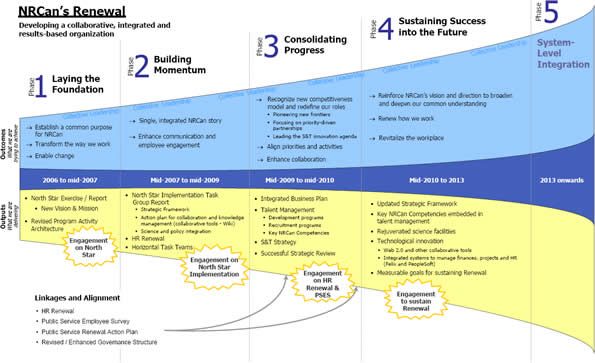
HR Renewal
The department established clear commitments in response to the 2009-10 Public Service Renewal Action Plan, and continued to apply integrated approaches to planning, recruitment, employee development and workplace renewal. NRCan continued its commitment to excellence in people management, recognizing that its employees are central to achieving its priorities efficiently. The department achieved results on key talent management initiatives through effective governance, collaboration and innovation. For example, NRCan's targeted On-Campus Recruitment Strategy and the implementation of Key NRCan and Key Leadership Competencies helped the department to increase its brand awareness as an employer of choice. In addition, building on the success of the Visible Minority Talent Management Program, NRCan was able to offer the career enhancement component of the program more widely, first to employees of other employment equity groups, then to all employees in the National Capital Region. NRCan also exceeded its 2009-10 targets for the Term Employee Management Strategy. By managing risk at a departmental level, NRCan is using indeterminate staffing to retain many talented young professionals previously employed as term employees.
Knowledge Management and Collaborative Technologies
NRCan improved several processes and systems during 2009-10. For example, a major achievement was the completion of a review of existing legacy systems and the identification of ways to streamline and maintain key business functionalities. This enabled the design of an efficient system which integrates finance, material and project
management. To implement this system, a Memorandum of Understanding was signed with Agriculture & Agri-Food Canada for collaboration on and implementation of a shared SAP system. This approach leverages expertise and is a cost-effective solution for replacing an aging financial system as well as many other stand-alone systems. The department also reached several milestones related
to the PeopleSoft version 8.9 upgrade.
In support of knowledge management, NRCan expanded the departmental knowledge search to new collaborative tools including NRTube and Sharepoint, and received approval of a new departmental policy on Information Management, to further support the development of an integrated knowledge base. It also successfully merged the content of NRCan’s Library catalogues using an open-source system known as Evergreen.
To strengthen delivery of internal projects, NRCan received approval of the NRCan Project Management Framework and launched the departmental Project Management Office.
Integration of Science and Policy
NRCan capitalized on research results and focused on facilitating communication of these results to those policy makers who need to understand and integrate this vital information. Moreover, the department developed a Science and Technology Strategy that positions NRCan as a recognized source
of world-class natural resources S&T, a champion of applying S&T for sustainable natural resource advantage, and a leader in integrating S&T with policy and program decision-making. This strategy supports the Government’s
S&T objectives of fostering Canadian advantages in entrepreneurship, knowledge and people.
Financial Management
A two-year, 8-point plan to strength NRCan Financial Management was developed and implemented, leading to the strengthening of active monitoring, clearer governance, accountability and roles and responsibilities. Furthermore, organizational and governance structures were improved, notably through the creation of the Resource Management
Committee.
Real Property
NRCan successfully implemented Year 1 of the Accelerated Infrastructure Program – Modernizing Federal Laboratories*, Polar Continental Shelf Program* (Resolute, Nunavut) and Accelerating Federal Contaminated Sites Action Plan* (Booth Street, Ottawa, Ontario). 141 (93 percent) of the 151 original work
items within the twelve projects were implemented. This has resulted in significant upgrades to NRCan facilities and improvement to the department’s scientific capacity, while at the same time creating local employment. Moreover, 171 jobs were created based upon benchmark stimulus employment metrics (1 job per $100,000 in infrastructure
investment). Addressing deferred maintenance and the modernization of NRCan laboratories ensures the ongoing integrity of these physical assets that support regulatory functions and programs in research and technology development. An audit of the Accelerated Infrastructure Program109 concluded that the program’s management framework is well controlled.
Ministerial Portfolio Coordination
Fiscal year 2009-10 was the first full year of a dedicated portfolio coordination function being in place at NRCan. Benefits included the provision of integrated advice on government-wide initiatives, policy, program and funding submissions that affected the portfolio; proactive management of portfolio issues based on environmental scanning; and
the coordination of planning and performance reporting activities from a portfolio perspective. NRCan also developed a Portfolio Management Framework that articulates the principles of effective portfolio coordination. The Treasury Board Secretariat acknowledged an improvement in NRCan’s
portfolio function as part of Round VII of the Management Accountability Framework assessment.
Integrated Business Plan
In addition, NRCan produced the first departmental Integrated Business Plan, which provides a more detailed roadmap on how the department is working to achieve its vision, and how activities support priorities. It also illustrates how all sectors of the department are working together to deliver
on its commitments: by integrating its people, its physical and information assets, and its finances.
The department also introduced quarterly reporting to monitor and track its progress in the delivery of programs and EAP initiatives. Early detection of problem areas enabled program managers to make informed decisions and implement corrective actions where necessary, thus increasing the likelihood that programs would be delivered within plans, timelines and budgets.
As indicated by the results from Round VII of the Management Accountability Framework assessment, NRCan's overall management is on track. The chart below shows NRCan’s improvement. In 2009, out of the 12 areas assessed, 2 were rated as Strong, 10 were Acceptable, and 0 were rated Opportunity for Improvement.

